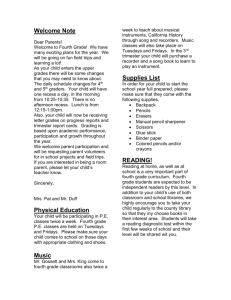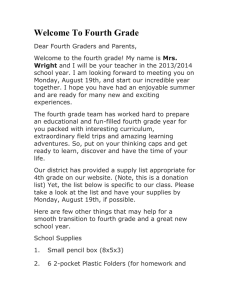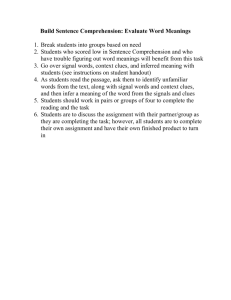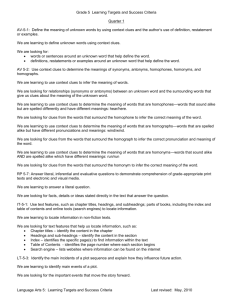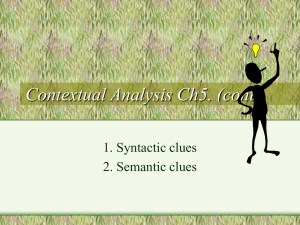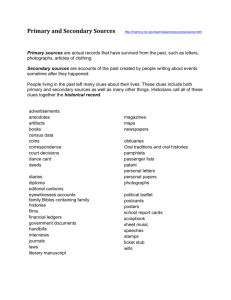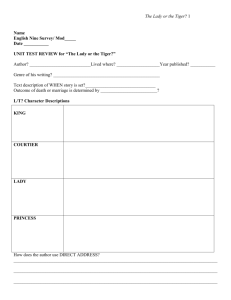4th Grade-Reading Standards
advertisement
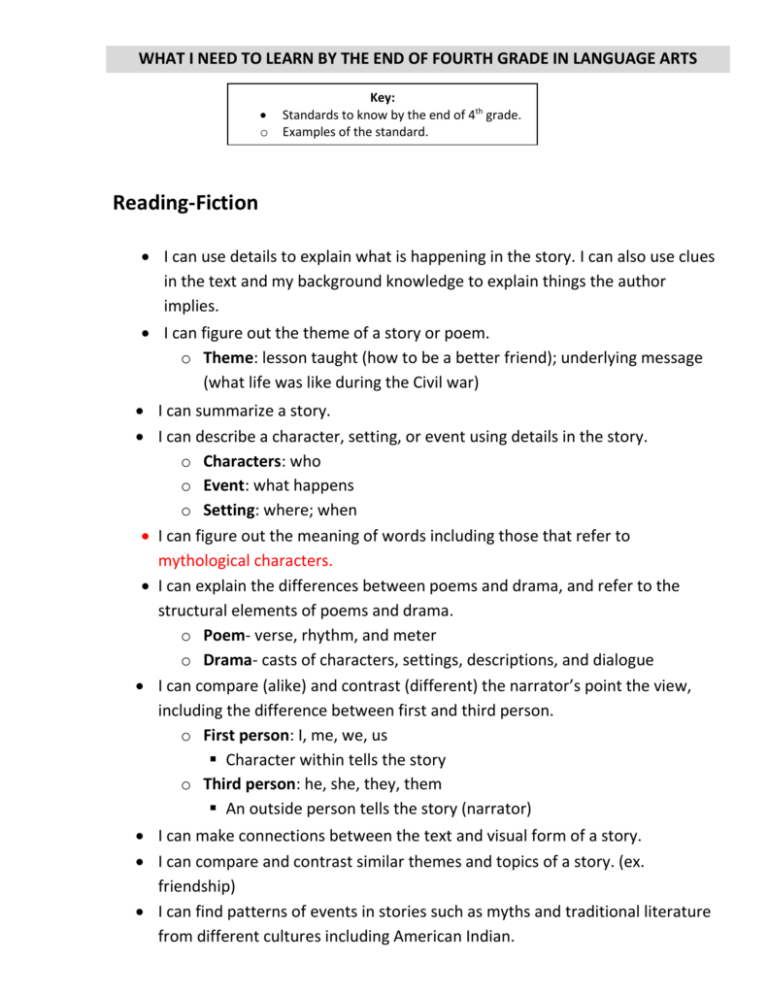
WHAT I NEED TO LEARN BY THE END OF FOURTH GRADE IN LANGUAGE ARTS o Key: Standards to know by the end of 4th grade. Examples of the standard. Reading-Fiction I can use details to explain what is happening in the story. I can also use clues in the text and my background knowledge to explain things the author implies. I can figure out the theme of a story or poem. o Theme: lesson taught (how to be a better friend); underlying message (what life was like during the Civil war) I can summarize a story. I can describe a character, setting, or event using details in the story. o Characters: who o Event: what happens o Setting: where; when I can figure out the meaning of words including those that refer to mythological characters. I can explain the differences between poems and drama, and refer to the structural elements of poems and drama. o Poem- verse, rhythm, and meter o Drama- casts of characters, settings, descriptions, and dialogue I can compare (alike) and contrast (different) the narrator’s point the view, including the difference between first and third person. o First person: I, me, we, us Character within tells the story o Third person: he, she, they, them An outside person tells the story (narrator) I can make connections between the text and visual form of a story. I can compare and contrast similar themes and topics of a story. (ex. friendship) I can find patterns of events in stories such as myths and traditional literature from different cultures including American Indian. I can independently read and comprehend a variety of literature at a fourth grade level by the end of the year. I can choose books that I find interesting and enjoyable. Reading-Nonfiction I can use details to explain what is happening in the text. I can state the main idea and supporting details. o Main idea- may be one word or a sentence summarizing the topic of the text o Details- support the main idea I can explain events using multiple texts (ex. historical, scientific, or technical) stating what happened and why. I can determine the meaning of words from a text written at a fourth grade level. I can describe the structure in a text. I can compare and contrast an event or topic including Minnesota American Indians. I can understand information presented in charts, graphs, timelines, etc. I can explain how an author uses reasons and evidence to support particular points in a text. I can use information from two texts on the same topic to write or speak about the subject knowledgeably. I can independently read and comprehend informational texts at a fourth grade level by the end of the year. I can choose books that I find interesting and enjoyable. Reading – Foundational Skills I can decode unknown words by looking for root words, prefixes, suffixes and other word patterns. o Root words (base): unreadable (root word is read) o Prefix- added to the front of a root word; preheat o Suffix –added to the end of a root word; joyful I can read aloud unfamiliar grade-appropriate text with accuracy, fluency, and comprehension. I can read aloud fiction and nonfiction (factual) text with fluency and accuracy. o Pacing (appropriate speed) o Intonation (changing tone of voice) o Expression I can use context clues and word structure to determine word meanings. Writing I can write opinion pieces, informative, narrative and other creative texts. I can write a piece with a topic sentence, supporting details, and a concluding statement. I can select writing topics that I enjoy. Language I can use pronouns and adverbs. o Prounoun - words that take the place of a noun (I, you, he, she) o Adverbs - words that describe a verb (quickly, slowly, finally) I can use and understand proper verb tenses (past, present & future). I can use adjectives to describe nouns. o Adjective- word that describes a noun (red, small, two) I can form and use prepositional phrases. o Prepositional phrase - under the table, above the cabinet I can tell the difference between a complete sentence and a run-on sentence. I can correctly use frequently confused words. o Homonyms: their, there, they’re o Multiple meaning words (homograph): I can’t bear to do this myself; I saw a bear in the woods. I can use correct capitalization, punctuation, and spelling when writing. I can use context clues and word structure to determine word meanings. I can use common fourth grade Greek and Latin prefixes, suffixes, and root words as clues to the meaning of a word. I can use print and digital reference materials (dictionaries, thesauruses, glossaries) to figure out meaning or pronunciation of a word. I can identify and determine the meanings of similes and metaphors. o Simile: comparing things using “like” or “as” He eats like a pig. o Metaphor: comparison of two thoughts without using “like” or “as” The clouds are a zoo in the sky. I can understand the meaning of a word by relating it to its antonym (opposite) and synonym (similar). o Synonyms: hot/warm o Antonyms: large/small I can learn and use fourth grade vocabulary. Speaking, Viewing, Listening and Media Literacy I can cooperate and problem solve to help my group when discussing. I can follow agreed-upon rules for discussion. I can publish work and share it with an audience. I can create an individual or shared multimedia project. I can ask and answer questions to clarify information and make comments that link to the remarks of others.



